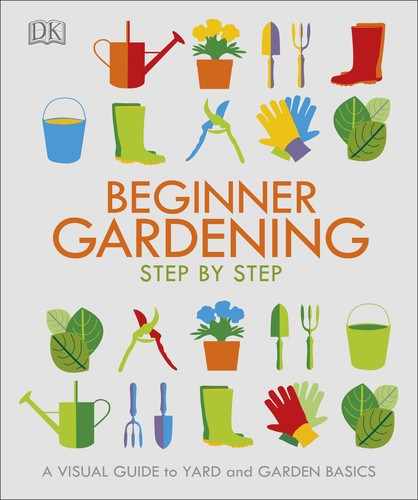
KNOW YOUR SOIL
Understanding what kind of soil you have will help
you to decide which plants will thrive in your garden
and ensure the best results. You can always make
improvements to your soil, but you also need to work
with its basic type.
KEY POINTS
• Finding out your soil’s properties
saves time and money, enabling
you to buy suitable plants.
• Look around local gardens and
make a note of the plants that
grow well in your area. These are
all likely to be suited to your soil
type and therefore an excellent
indication of what will flourish
in your own garden.
SEE ALSO
• IMPROVE YOUR SOIL >> 16/17
• MAKE COMPOST >> 234/235
THE PERFECT SOIL
All plants have different needs.
However, loam—a mix of clay
and sand—is generally seen as a
good thing. Ideal soils also have
a fairly neutral pH and contain a
good amount of organic matter.
Testing acidic soil Acidic
soils are lime-free, unlike
limy, or slightly chalky,
alkaline soils. Some plants
will grow well in acidic
soils, but others won’t.
Buy a soil pH test kit from
a garden center to assess
soil acidity. At home, take
soil samples from around
the garden. Shake each
soil sample in the chemical
solution, then leave the
mixture to settle.
Determining acidity Match the color
to the card in the test kit. The pH scale
runs from 14 (very alkaline) to 1 (very
acidic), with 7 being neutral.
US_012-013_Assessing_soil.indd 12 07/09/2018 16:31

GETTING STARTED // KNOW YOUR SOIL 12–13
If you can mold your soil sample in your
hands and get it to hold its shape, you have
clay. When moistened, it feels slimy.
Rolling a sample into a sausage and
bending it into a ring reveals a very
clay soil.
Test for sandy soil by rubbing earth
through your ngertips. It will feel gritty.
Squeeze and release soil then press lightly
with your thumb. Sandy soils will crumble.
Testing sandy soil Easy to
turn and weed, sandy soils often
heat up earlier in spring than clay
soils. Their free-draining nature
can be an asset for growing
certain plants, but during heavy
rainfall precious nutrients can
be washed away. As a result,
sandy soils may be quite low in
nutrients. The more sand a soil
contains, the more it will crumble
when a handful is compressed,
because it has very little of the
sticky bonding agent supplied by
clay particles. Soils with a high
sand content will feel coarse,
gritty, and dry when worked
through your fingertips.
Testing clay soil While clay
soils are potentially the most
fertile and productive, clay
particles are extremely fine and
slippery when wet, forming a
dense paste that sticks to boots
and garden tools. Soils that have a
very high clay content can become
waterlogged and “puddle” in
wet weather, or set like concrete
and crack in droughts. In such
situations, clay soil can be greatly
improved by adding plenty of grit
and organic matter.
US_012-013_Assessing_soil.indd 13 07/09/2018 16:31

US_014-015_GettingStarted_DPS.indd 14 07/09/2018 16:31

Growing your own plants from seed is a
simple and inexpensive way to ll your garden.
First nd out about your garden’s aspect and soil,
and then start to plan what you want to plant
and grow.
US_014-015_GettingStarted_DPS.indd 15 07/09/2018 16:31
..................Content has been hidden....................
You can't read the all page of ebook, please click here login for view all page.
